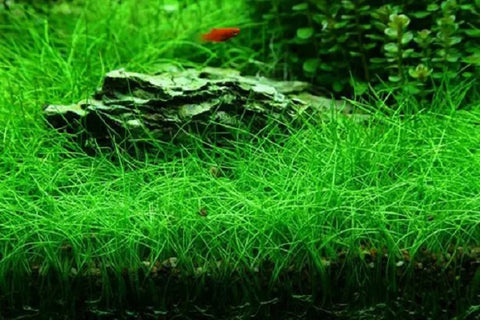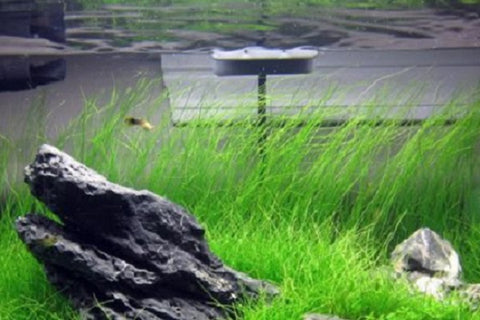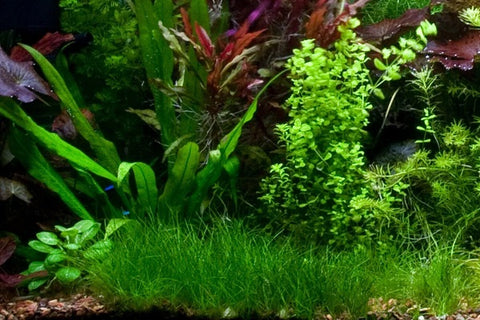Planting dwarf hair grass is no rocket science. With some diligence, time and effort, you can create the best-looking aquarium covered by lush green grass carpet, also acting as a hiding spot for the water critters in your tank.
Eleocharis parvula is the scientific name for the commonly known dwarf hair grass. These are mostly found along with small water bodies, like rivers and lakes, in muddy areas.
Guide to planting dwarf hair grass
Here we have discussed the planting of hair grass and tips to expedite the process.

1. Prepping the tank
Start by choosing the right sized tank. Dwarf hair grass grows best in shallow tanks so they can absorb maximum light. Lay a 1.5 inches thick substrate layer covering the tank’s bottom.
Most experts recommend using a soft substrate like sand to make it easy for the roots to grow deep inside. It certainly doesn’t imply that you cannot use a coarse substrate, like gravel.
But remember, the harder the substrate, the longer it takes for the hair grass to carpet the aquarium.
2. Placing the grass patches in the substrate
Now cut the hair grass into tiny patches (with 5-6 grass blades) and place them within the substrate such that the roots are entirely buried inside with the shoots standing above. The dividing of hair grass is to facilitate fast growth. The smaller the patches, the less time they will take to grow.
Some might skip over the toil and place larger patches, but it will take too long for the hair grass to carpet the aquarium. With smaller patches, the hair grass will cover the aquarium bottom within a month, provided that there are enough nutrients and light available.
- While planting, ensure the grass patches are placed an inch (or slightly less) apart.
- Trimming the roots before planting is crucial to stimulate growth in the hair grass.
3. Post planting ritual
After a few days of planting, experts recommend trimming the grass blades, and this is to make the growth process faster. Some blades might turn yellow or brown after the planting due to the change in the environment, and the effect can be nullified by trimming them. Fresh, green grass will grow after a few days of trimming.
4. Setting the right conditions
Ensure the aquarium has proper lighting to carry out the essential phenomenon autosomes carry to create their food - photosynthesis.
Dwarf hair grass is among those aquarium plants that cannot survive without light. A minimum of 8 hours of exposure to light is a prerequisite for them to grow. For that purpose, we recommend using an automatic light system for your convenience.
Ideal conditions to expedite the growth of dwarf hair grass
If you plan to speed up the growth process, the following are the optimal conditions in which dwarf hair grass thrives.

Temperature
A temperature between 10-28°C is suitable for their fast growth. This tolerance to a wide range of temperatures makes them hardy and easy to maintain.
pH value
A neutral pH of around 7 makes them grow faster.
Nutrient levels
To carry out the process of photosynthesis, hair grass needs nutrient-rich water. Low nutrient levels in the tank water can trigger the yellowing of the grass blades.
Carbon dioxide
Carbon dioxide is the primary reactant of the photosynthetic reaction and should be in the right amount to facilitate the growth of hair grass.
For this purpose, use a carbon dioxide meter to measure the gas levels in the water. There are various ways of adding carbon dioxide to your tank, through regulators, injections, and infusers.
- Replenish with fertilizer
Stunted growth or discoloration of the grass blades signifies the low levels of nutrients in the tank water, which can be undone by adding fertilizer. A fertilizer (mainly one rich in iron) will replenish the water with nutrients keeping the hair grass in a good mood.
Please consider not exceeding the moderate level of nutrients in your tank water, or else you will unintentionally create a favorable environment for algae, which is not only unpleasant to the sight but will also compete with your aqua plants for nutrients and carbon dioxide, suffocating them to death. In the case of any algal growth in the tank, use algae eaters to solve the problem.
What makes them an ideal choice?

1. Fish won’t damage them
One good thing about the dwarf hair grass is that due to their thin blades, fish don’t enjoy snacking over them. Thus, it is least likely to be destroyed, making it an ideal choice for adding to the aesthetics of your aquarium. However, some larger fish notorious for aggression might show interest in damaging your small green field.
2. Easy to maintain
Their easy maintenance is to die for. Unlike most aqua plants, dwarf hair grass will only need trimming once in a while to ensure they look tidy and don’t hinder the swimming of your fish.
They don’t grow too high, and the maximum length these can reach is no more than five inches, making them more manageable.
Remember, remove the trimmed grass blades from your tank water after trimming, as the last thing you want to do is clog your filter. Also, the more organic waste inside the water, the more cleaning is required.
3. Compatible with many fish species
Dwarf hair grass is easy-going and doesn’t have compatibility issues, making them a befitting choice. Rasbora, Tetras, Shrimps, Guppies, Danios, Mollies, and Loaches are some hair grass compatible fish species. They also get along well with other plants, but too many of them can result in a competition causing the death of one or all competing parties.
Concluding words
Planting dwarf hair grass involves a series of simple steps, like prepping the substrate, cutting the hair grass into tiny patches of 5-6 blades, trimming their roots, placing them an inch apart from one another, and finally trimming the blades after a few days to make them grow faster.
We recommend prepping your aquarium and growing the hair grass before adding the fish and other water pets inside. After following our guide to planting dwarf hair grass, you are not far from having a lush green carpet for your aquarium, giving off oxygen to your tiny critters and simultaneously removing toxins.


Comments (0)
Back to Beginner Guide & Advice